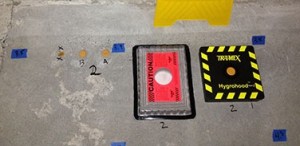A lot of time and money is invested in various types of flooring materials as part of the interior design theme for nearly all office and retail spaces. Unfortunately it can all be in vain because of latent subfloor conditions. Most all commercial buildings have concrete subfloors: slab-on-grade at the 1st level with above floors either concrete on metal deck, post-tensioned, or pre-stressed concrete. The problem all too often is the moisture content of the concrete subfloor that can cause many different types of finish flooring to lose adhesion or to not lay flat. Regardless of the age of the concrete subfloor , its moisture content can be quite high. The consequences are often a new floor finish that “blisters”, curls, or otherwise simply comes apart. Plenty of disputes arise over responsibility which can sometimes be relatively expensive to resolve.
There are two common ways to check the moisture content of a concrete subfloor before installing the finish flooring: 1) Calcium-chloride test, and 2) In-situ probe/data loggers. For our clients  Promaneer always recommends the probe/data loggers for greater sampling and better data well prior to floor preparation. Calcium-chloride tests, while standardized by ASTM and still mandated by most flooring manufacturers for product installation requirements, is generally a 24-hour test period and thus a snapshot of the floor at the time of the test. The probes on the other hand log their relative humidity readings, which are monitored within the slab, over a determined time period – days or even weeks. This is preferred for our clients because the building conditions vary especially with HVAC operation, which significantly influence the rise and fall of the temperature and moisture within concrete floors.
Promaneer always recommends the probe/data loggers for greater sampling and better data well prior to floor preparation. Calcium-chloride tests, while standardized by ASTM and still mandated by most flooring manufacturers for product installation requirements, is generally a 24-hour test period and thus a snapshot of the floor at the time of the test. The probes on the other hand log their relative humidity readings, which are monitored within the slab, over a determined time period – days or even weeks. This is preferred for our clients because the building conditions vary especially with HVAC operation, which significantly influence the rise and fall of the temperature and moisture within concrete floors.
Projects on which Promaneer has been called to reconcile flooring problems have ranged from resilient tile (VCT) to terrazzo to rubber gymnasium flooring, all of which failed and portions delaminated off of their respective concrete substrates. The common denominator: the flooring installer complied with the manufacturer’s installed guidelines for testing the moisture content of the concrete prior to floor prep and installation via a calcium-chloride test. In some cases for which the test results exceeded the allowable limit established by the manufacturer, a liquid membrane vapor barrier was applied over the concrete yet it too failed and delaminated. The relative humidity (RH) in those cases was later tested using in-situ probes and one charted over 90% for a prolonged period.
What to do? Short of tearing out the concrete or test coring to check for an underslab plastic vapor barrier, its suitability for the specific use application, and its permeability, what else can be done? What if you are a tenant and the delivery condition of your leased space does not specify the maximum limits of the concrete RH or even its pH? Even some building owners who hired Promaneer after attempts to remedy the situation with new, but expensive liquid-applied membranes were exasperated in the end.
As previously mentioned concrete age is irrelevant. We have encountered 50+ years old concrete with high RH, but more commonly on new construction because the typical project schedule demands speed over full cure time and acclimation of the concrete floors before finish flooring is installed. Regardless of the project a solution should always developed specific to:
- desired flooring and intended use,
- building shell and envelope,
- HVAC,
- percentage of RH in concrete logged by the in-situ probes,
- flooring product and labor warranties, and
- time and costs
Together all of these must be carefully considered and balanced in order to make the appropriate selections for products, installer, and warranty. The last thing any end-user wants is to deal with a dispute over failed flooring and why, which tends to be compounded by a number of other contributing factors.
A good commercial flooring installer will proactively identify potential issues before putting down your flooring, or even before purchasing the materials knowing from experience that the customer’s selection, while superb-looking, will probably fail because of certain predictable conditions at the project site. You may have to pay more than the lowest bidder’s number, but a knowledgeable, upfront installer will save much of the back-end costs and headaches that can spiral well after occupancy.
Always insist on in-situ probes sufficiently in advance of the scheduled flooring installation but during the steady-state interior climate conditions. Also check the various manufacturer’s warranties and disclaimers, not only for the flooring product but also for the prep materials, adhesives, levelers, etc. The fine print in warranties is an aching read, but can avoid the untimely late discoveries afterward as to what was and was not covered. If possible, insert language in your construction contract specifying the owner’s requirements and turnover metrics for concrete floors upon completion. If turn-key, include detailed language for transferring and/or allocating the risk of any post-construction finish flooring failure to equitably include the constructor and installer. Likewise, if a tenant, negotiate your delivery condition and work letter accordingly (base building vs TI). Promaneer assisted one client by successfully including concrete probes as part of their tenant site survey which provided “hard data” on the space used during their lease negotiation.
